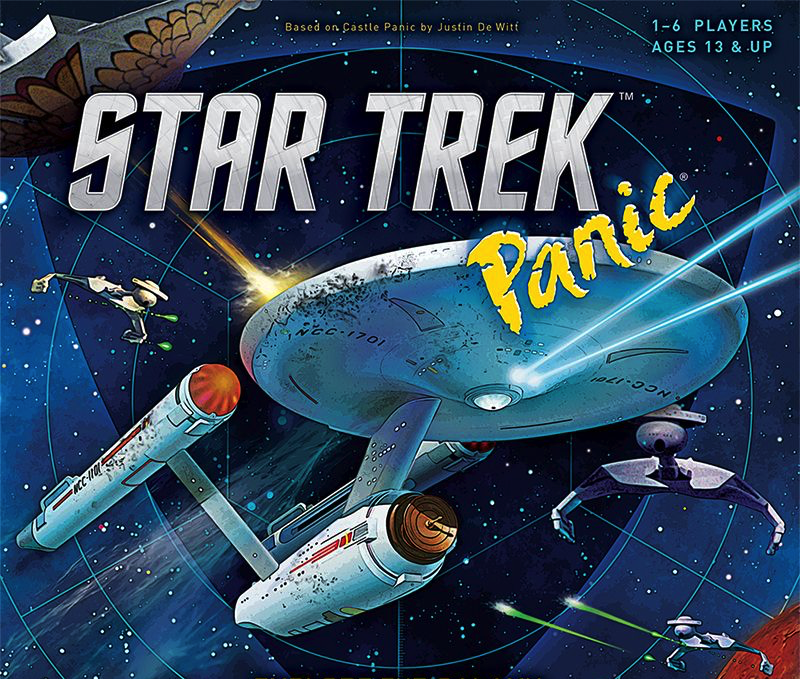I first played Star Trek Panic in 2018, playing it twice, and I loved it so much I bought it for my father for his birthday, as he was a fan of Star Trek when it premiered. Well, neither he nor I ever got around to playing the game until I visited him recently. I’ve now played it six times total, working through all the missions twice.
Star Trek Panic is a cooperative game where each player is one of the main characters from Star Trek: The Original Series—Kirk, Spock, McCoy, Uhura, Scott, Sulu, or Chekov. Each character has a special ability: for instance, Sulu can maneuver the Enterprise twice, Scotty can repair a damaged shield or hull, Chekov can do an additional damage on a phaser hit.

To win, players must achieve five missions (Star Trek: The Original Series was originally on a Five-Year Mission) while keeping the U.S.S. Enterprise from being destroyed. For missions, players must commit specific types of cards from their hand to achieve the mission (cards have an added currency, such as Engineering, Science or Command) within a set number of turns. For instance, for the Immunity Syndrome, players need to maneuver the Enterprise alongside a giant space amoeba within five turns, then commit cards to destroy it. For The Trouble with Tribbles, they must maneuver alongside a Klingon vessel in six turns, then beam the tribbles there (by committing certain cards). Working through all 18 missions was one of the aspects that kept drawing me back to the game. Most missions are easy to achieve; typically, we’d only fail one mission per game.

On a player’s turn, they draw up to their hand size of six cards, reveal a new mission (if needed), trade one card with another player, play from their hand and maneuver, then check the mission, move and first existing enemy spaceships, then draw two new threats to the board. Unlike in The Original Series, in the game there are lots of enemies. At the end of their turn, the current player draws two tiles from the bag: these are typically Klingons [7 of the 79 episodes of TOS], Romulans [3 episodes] or Tholians [1 episode]. In fact, the game has you place one of each type during setup. There are some other threats: comets, ion storms, temporal distortions, etc.—each with special instructions.

Since most cards in your hand fire in a specific direction and/or range, you are typically spending turns using the cards that make sense for the current orientation, then moving the ship, then using the rest of your cards that apply.

That loss was unfun though – you lose when all six hulls of the Enterprise have been destroyed. However, once you’ve had three hulls destroyed you can no longer maneuver, and the game becomes unwinnable unless you are able to quickly repair one of those hulls. Our loss turned into a real slog; I might add a house rule that once you have four hulls destroyed, you lose. My other house rule: cloaked ships move to a new location on a roll; 1-2, counterclockwise (maybe), 3-4 stay in the same spot, 5-6, clockwise. The point is we could never remember, and I’d just have the ship move to the zone of the number rolled (as there are six zones).
Star Trek Panic is based on Castle Panic which was, for its time, a revolutionary cooperative tower defense board game. My kids loved Castle Panic when they were tweens and younger, and we played many of its expansions. The key changes in Star Trek Panic are the ship maneuvers (towers don’t move) and mission cards. While enjoyable, Star Trek Panic lacks the relentless pressure of Castle Panic. We almost never were unable to complete a mission, and while the ship was often very damaged at the end, we survived five out of six times we played.
The cardboard Enterprise is a joy, as are the components with the shields and damage tokens. Also fun is maneuvering the ship: moving one step clockwise or counterclockwise or moving “forward,” where enemies in front move closer. The game is great for its thematic immersion and its cooperative nature.


The cautionary tale for boardgame publishers is that there are simply so many games published that you can see a game you like and yet never get it to the table again for years. (See U.S. Gamers Prefer the Familiar.) While Star Trek Panic is out of print, you can find it on eBay or by carefully accessing the Guardian of Forever.
Image credits: Promotional images from USAopoly. Last two images copyright 2023-2024 CC-BY-SA 4.0 by J. Alan Henning.



You must be logged in to post a comment.